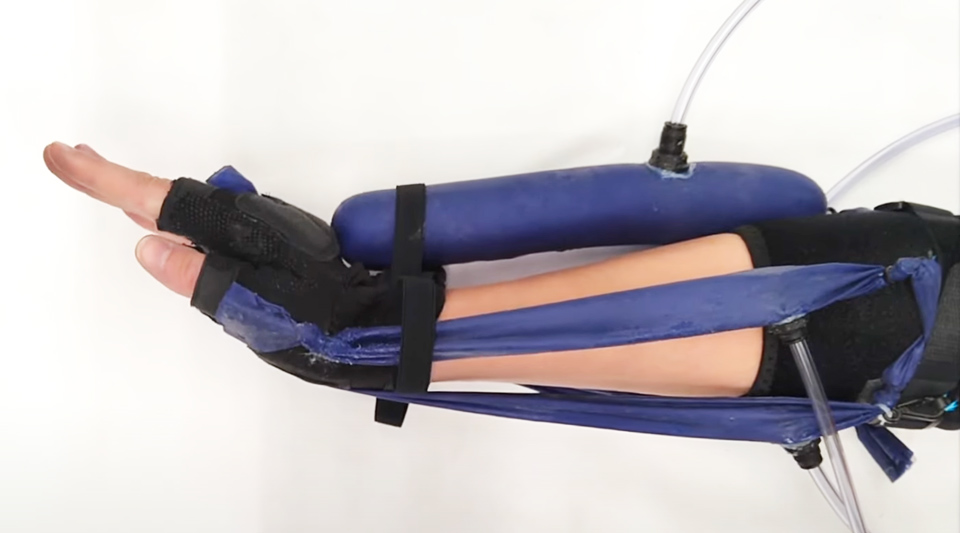The phrase “robotic exosuit” likely calls to mind something metallic, rigid, and hinged. We might think of Iron Man’s suit or the dozens of other, similar apparatuses that appear on screen, in video games, and even on the red carpet. However, researchers at the University of Notre Dame are working to show that for many real-world applications, there is value in exploring robotics’ softer side.
“Soft exosuits can help solve several engineering challenges,” explains Margaret Coad, whose lab recently published a paper on a soft robotic exosuit designed to fit the wrist.

“A key problem in exosuit design is how to avoid misalignment between the body and the device,” she says. “Soft exosuits can handle that problem more easily than their rigid counterparts. Our design showcases how soft actuators—rather than traditional motors—allow for a very lightweight and comfortable wearable device.”
Coad, an assistant professor in the Department of Aerospace and Mechanical Engineering, developed the design with doctoral student Katalin Schäffer. The pair’s prototype utilizes four soft actuators positioned around the wrist—one in front, one in back, and one on each side.
The actuators inflate and outwardly resemble the modeling balloons used for twisting into animal shapes. However, Coad’s actuators are not rubberized; they are made from an extremely strong and intricately woven, airtight nylon fabric. Each actuator stretches from a mounting point on the forearm to a point on the hand below the fingers.
“This type of muscle is not only lightweight, durable, and foldable; it can also exert incredible force with a quick response time to inputs. We’re still exploring all the applications and benefits this opens up.”
Through precisely controlled inflation and deflation, the soft actuators tighten and relax like muscles. As each actuator fills with air (flexes), it draws the wrist toward it. As it deflates (relaxes), it allows the wrist to move away. A custom-designed software program coordinates the tradeoffs between the muscles that allow the wrist to move in all directions with support on all sides of the wrist.
Among the first to try the new exosuit were U.S. Senators. Directly following their paper’s publication, Coad and Schäffer traveled to Washington, D.C., where they demonstrated their prototype at the Senate Robotics Demo Day.

Coad says she was proud to bring a focus on soft robots to the day’s demonstrations. “Soft robotics allows us to rethink what the body of a robot should be,” she says. “It helps us expand what robots are capable of by using new materials and mechanisms for creating motion and force.”
Coad points out that in addition to avoiding discomfort from weight, rigidity, and joint misalignment, the soft exosuits bring an added benefit: They tend to be low-cost. Whereas existing upper limb exoskeletons cost tens of thousands of dollars, the wearable part of the suit costs just $134 in materials, minus the off-board components and compressed air source that power it.
Low-cost designs are important, Coad says, because they can help get the benefits of robotic exosuits into the hands—or onto the limbs, rather—of more people more quickly. That has been true for one of the first groups to benefit from the new design: stroke survivors. Schäffer has been exploring ways the device can aid in their rehabilitation and help expand their range of movement. The device’s affordability, combined with its portability, means that stroke survivors may be able to use the device in their homes without requiring visits to therapy facilities.
Coad and Schäffer say their initial wrist-focused served as a proving ground, but they say new designs for other parts of the body are on the way. They envision uses for the device that could help relieve soreness or stiffness and could complement traditional occupational therapy. The device could also aid in repetitive movement or even lifting.
As Coad points out, “This type of muscle is not only lightweight, durable, and foldable; it can also exert incredible force with a quick response time to inputs. We’re still exploring all the applications and benefits this opens up.”
The initial stages of Coad and Schäffer’s work were funded by the Ministry of Culture and Innovation of Hungary. Schäffer also received support from the O’Brien Family Endowment for Excellence Fellowship at Notre Dame’s Berthiaume Institute for Precision Health and the Edison Innovation Fellowship at the IDEA Center.
To learn more about Notre Dame’s collaborative group of researchers who bring cutting-edge robotics solutions to critical societal problems, visit https://robotics.nd.edu/.
Originally published at research.nd.edu by Brett Beasley on February 19, 2025.
